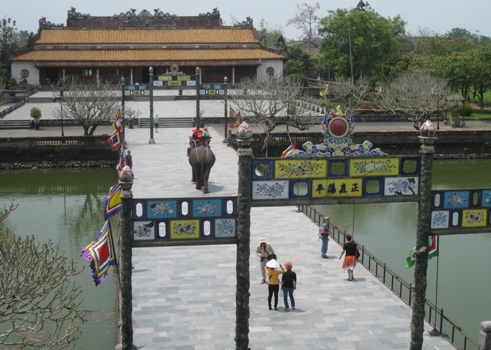The government of Thua Thien-Hue province has approved a project to preserve the Hue royal citadel, a world cultural heritage, at the cost of nearly VND1.3 trillion or USD62 million.

This is the largest-ever project to restore and preserve the Hue relic, performed by the Center for Preservation of Hue Ancient Capital.
With USD62 million, the outer layer of the Hue royal citadel, with a perimeter of 10km, will be repaired. Nearly 1,000 families who live in this area will be removed. The entire dike and ditch system as well as the citadel wall will be mended.
This project will be implemented from the end of 2011 to 2015. Of the VND1.3 trillion of capital, VND1.28 billion will be allocated from the state budget.
Hue was the capital city of the Southern Kingdom by all Nguyen Lords and officially became the capital under Tay Son\' reign. For approximately 400 years, Hue has become a great landscape and architectural site. Hue\' royal complex has been recognised by the UNESCO as a World Heritage Site.
The Hue royal citadel is situated on the northern bank of the Huong (Perfume) River, with an area of 500 ha and a system of three circles of ramparts, namely from outside to inside: Kinh Thanh (Capital Citadel), Hoang Thanh (Royal Citadel) and Tu Cam Thanh (Forbidden Citadel).
This construction stared in 1805 under the reign of Emperor Gia Long and completed in 1832 under the reign of Emperor Ming Mang. Under Nguyen\' reign, Kings have ordered to build ramparts, palaces and constructional works of royal. Over 200 years to now, it is still original with nearly 140 small and large constructions.
The citadel is square in shape and almost 10km in circumference, 6m high, 21m thick and 10 entrances. On the top of the walls that surround it, 24 bastions are established for defensive purposes. Besides, the citadel has an ancillary gate connecting the Tran Binh Bastion called the Thai Binh Mon (Peace Gate).
The Imperial City is located in the center of the citadel where established highest offices of Vietnam\'s feudalism and sanctums honoring the cult of decreased Emperors. The citadel, also has a nearly square form, with more than 600m long for each side, built of brick 4m high, 1m thick, around which is ditched a system of protection trench.
Access to the Imperial City can be made by four entrance gates. Noon Gate is only used for the King. Royal Palace consists of more 100 beautiful constructional works divided many sectors.
Located inside the Imperial City, behind the Throne Palace, the Forbidden Purple City is reserved for Emperor and his family. It was built early in Emperor Gia Long\'s reign in 1804 with brick walls 3.72m high, 0,72 m thick, about 1,230 m in circumference. Its front and back sides are 324 m each while either left and right side is more than 290 m including 50 architectural constructions of different sizes and 7 gates for facilities of entrance and exit.
Dai Cung Mon (the Great Place Gate) is in the front side for Kings. Can Chanh Palace (the place for every day working of Emperors). Can Thanh (Emperor\'s Private Palace), Khon Thai Residence (Queen\'s Private Apartment) reserved for the Queen. Duyet Thi Duong house (Royal Theatre), Thuong Thien (the kitchen for the King\' food), Thai Binh Lau (King\'s reading room).
Besides, Hue is also famous for royal tombs and temples of Nguyen Kings. Seven tombs with different aspect are not only a wonderful arch but also combining beautiful, imposing nature and poetic of Hue.
Ancient Hue including Perfume River and Ngu Mountain, palaces and citadels, tombs and temples with hundreds of historic years are being embellished and recovered by material contribution of Vietnamese and International community in order to keep Hue City as cultural heritage of World.

Leave your comment on this story